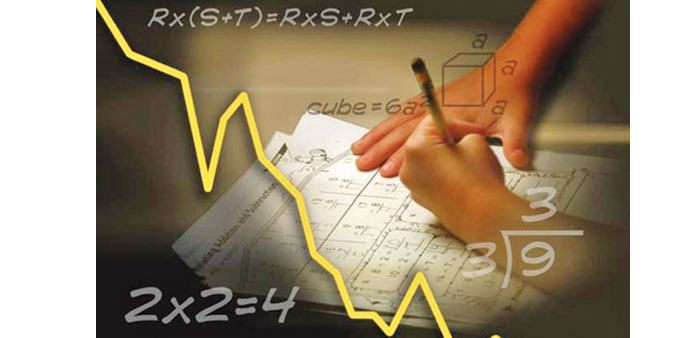|
After the excellent performance of Shanghai children in the Programme for International Student Assessment (PISA), an expert delegation led by British Education Minister Elizabeth Truss paid a visit to Shanghai recently to learn from the city’s experience in teaching - and teaching math, in particular. |
The local press reported that the visiting delegation was utterly stunned by the Shanghai schools’ demonstration. They were particularly impressed with the children’s mastery of the multiplication tables, which made mental arithmetic easy for them. Now Britain has even invited 60 Shanghai schoolteachers to teach in the UK.
I certainly hope that a Chinese pedagogic approach is so great that the world can learn from it. I was once asked by my American professor about pedagogy from a Chinese point of view. The professor was pretty disappointed with my answer: “This is still American thinking. What I’m interested to know is what the East’s unique contribution to this issue is.”
Needless to say, I was embarrassed. I would love to proudly declare that a Chinese approach to education is the model for the world. But alas, that does not seem to be the point.
According to my observations of American school homework, while recalling my own learning in China as a child, I notice that structurally American and Chinese schools cultivate pupils’ knowledge and ability differently.
Therefore, it is far too simplistic to make conclusions such as “America’s math curriculum is simpler than China’s” or “Chinese students’ basic mathematical skills are more solid”.
As in an archery competition, only if every competitor uses the same target can a fair comparison be made. If there exist structural differences of content and the setting of skills (i.e., the what), simply comparing the outcomes (i.e., the how) won’t make sense.
When people say that Chinese students’ basic mathematical skills are good it usually refers to their good grasp of basic facts.
For instance Chinese pupils are indeed better in mental arithmetic and in memorising their times tables. However, when it comes down to good or bad performance, Chinese and Americans are probably not measured with the same standard, at least up to now.
In the US, primary and secondary school teachers like to emphasise “higher order thinking skills”, abbreviated as HOTS. Indeed, possessing these “HOTS” skills makes one “cool” in America: being able to judge performance, an analytical grasp of logic, ability in data analysis and interpretation, capability of coming up with a question and basic communication skills. Some of these characteristics are also linked to reading and writing capabilities.
In my view there exists a certain bias in this American educational approach - it looks down on “low-end” skills and lays particular stress from a young age on the “high-end” skills. Yet every skyscraper starts from zero. Without the base-level support, thinking of “knowledge” and “understanding,” and training high-end skills, would be like building castles in the air.
In this regard the US has begun to reform its approach, and is introducing a “Common Core State Standards Initiative” so that at the end of each grade pupils acquire a similar standard of basic skills and are prepared for further learning.
Likewise, taking into account the balance and rationality of knowledge structures, the Chinese education system would benefit from increasing students’ cultivation of “high-end skills”.
It should be said that Chinese and American education approaches have their own merits respectively. It is not necessarily true that Americans’ “basic skills” are worse than those possessed by Chinese people.
For example, a Chinese colleague here in America told me just the other day that he is attending math classes in his spare time. I asked him why and he told me his basic math skills are not great. Contrary to the general view that Chinese people have a firmer foundation in math, he believes that China’s math teaching is too focused on abstruse questions when pupils don’t really have sufficient comprehension.
Instead the American teachers teach not only “what” but also “why”. He said he finally understood certain subjects that he didn’t understand after relearning them again in America.
What is most worthy of learning from the Chinese system isn’t necessarily its specific pedagogic methods but the great importance that Chinese society places on education.
I have no clue what it’s like in the UK. But I feel there is some sort of anti-intellectual culture among American adults. When people say that their math is very poor it often sounds like they are actually proud of it. And it is true that the majority of Americans are not great in calculating simple sums.
Such a mentality naturally has an impact on children. One of my American colleagues told me that his son was worried about being popular, and therefore would occasionally deliberately perform less well in math.
Meanwhile, Chinese families don’t have such concerns. Moreover, because of cultural differences many Chinese families who live in the US continue to spur on their children to get good scores and ignore this American “hidden rule”.
My son does not receive any particular training in math, but to our surprise he was awarded first prize in our city’s math competition recently. We couldn’t care less about him being “cool” like the American children. And my son even jokingly announced that he is most pleased to be the “Asian math nerd”.
Family environments are what influence children the most. The strengths of Chinese students are, above all, their endurance and their willingness to work hard. This is of course a good habit, and is probably the very “skill” that is most worthy of teaching to American kids.- Worldcrunch/Caixin Media
♦ Nanqiao is a US-based education curriculum design specialist.



